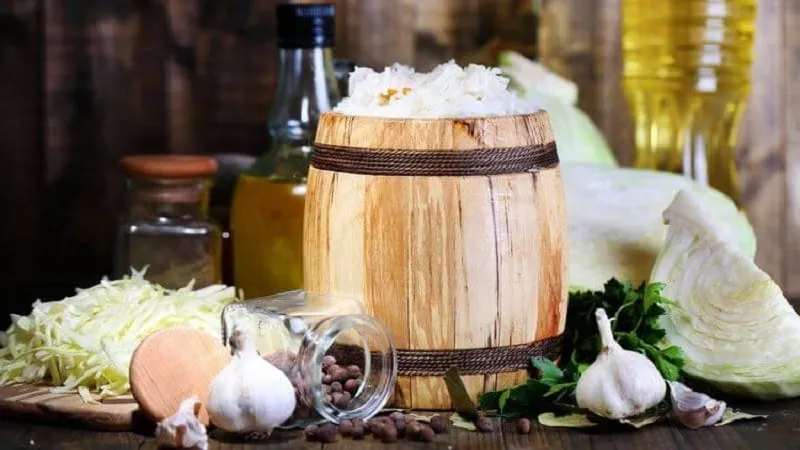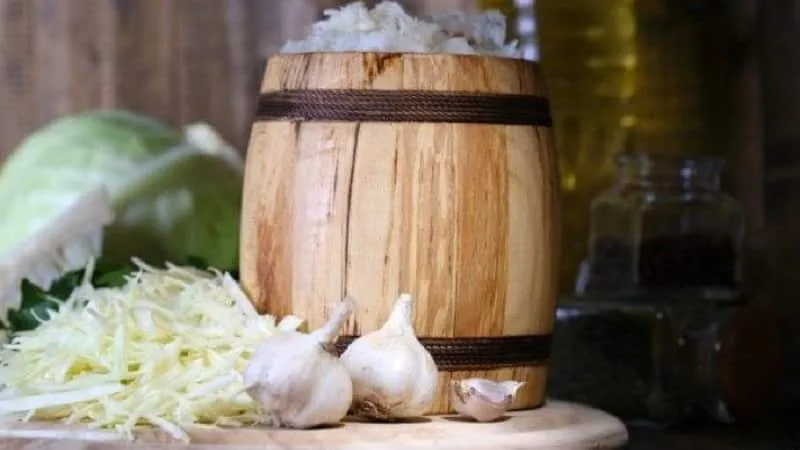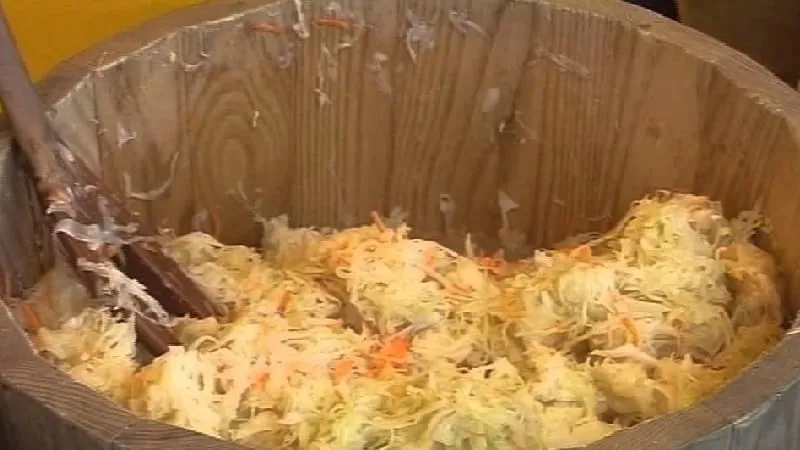Sauerkraut – a traditional fermented dish with deep roots in European culinary heritage. This method of preserving vegetables has been used for centuries. Cabbage fermented in a wooden barrel tastes better than when prepared in a jar. Barrels preserve both the flavour and nutritional qualities of the vegetables. Read on to learn how to ferment cabbage in a barrel for winter storage.
Table of contents
Which Barrels Are Best for Fermenting Cabbage
For fermenting cabbage, barrels made from various types of wood are used: oak, aspen, linden, and others. The choice of such containers is simple – they are made from eco-friendly materials without chemical treatments or welding. The type of wood is selected based on the contents to be stored inside.
The barrel production process remains the same regardless of the wood type. However, to choose the right material, it’s worth considering its pros and cons.

Oak
Oak has always been considered the best choice for making barrels for fermenting cabbage due to its durability and seasoning properties. However, preparing the barrel takes time, and the wood can impart a distinct flavour to the product.
Cedar
Cedar barrels are among the best because they ensure long-term storage without altering the taste. The downside is the high cost of the material.
Linden
Linden is popular for barrel-making due to its softness and appearance. Barrels made from this wood are suitable for storing fermented foods. However, they are less durable and dense compared to other woods.
Pine
Pine barrels are also suitable for fermenting cabbage, thanks to their lightweight and soft texture. However, the natural forest aroma of the wood may transfer to the product.
Aspen
Aspen preserves fermented vegetables until spring. However, as temperatures rise, it loses its properties – the cabbage may develop an unpleasant sourness if not relocated.
Recipes for Sauerkraut in a Barrel
Preparing ingredients is a crucial step in fermenting cabbage. All produce should be ripe and unspoiled – this determines the shelf life of the final product.
For the classic sauerkraut recipe in a barrel, you will need the following ingredients:
- 10 kg white cabbage;
- 1 kg fresh carrots;
- 250 g salt;
- 50 g sugar;
- 15 g black peppercorns;
- 50 g rye bread.
Step-by-step preparation method:
- Remove the outer leaves from the cabbage and shred the head into strips (not too finely) or grate using a specialised grater.
- Peel the carrots and grate them coarsely.
- In a separate bowl, mix the cabbage, carrots, salt, and sugar.
- Place a slice of dry rye bread at the bottom of the wooden barrel and cover it with whole cabbage leaves.
- Layer the vegetables tightly, pressing them down to release juice. Do not fill the barrel completely – leave space for the lid and weight.
- Cover the mixture with a double layer of cheesecloth.
- Place a weight on top and cover with the lid. Leave the barrel in a warm place for two days.
- Once a day, pierce the mixture to the bottom to release trapped carbon dioxide.
- After two days, move the barrel outdoors (at +8°C or lower) and leave for another three days.
- Store the finished sauerkraut outdoors or in a cool place where the temperature does not drop below 0°C.
It’s best to add vegetables gradually, in batches, to make mixing easier and maintain their texture. You can enhance the final product with cranberries or cloves.

Cold Fermentation Method
This method is very simple and requires no additional ingredients. First, prepare the barrel by washing and drying it thoroughly.
For fermenting cabbage, you will need:
- Cabbage – 10 kg;
- Carrots – 1-1.5 kg;
- Sugar – 50-60 g;
- Black peppercorns – 15-20 g;
- Rye bread;
- Salt – 200 g.
Preparation method:
- Remove the outer leaves from the cabbage and peel the carrots.
- Finely shred the cabbage with a knife or food processor; grate the carrots coarsely.
- Mix the vegetables and spices in a separate bowl.
- Use rye bread as a starter by placing it at the bottom of the barrel.
- Add the vegetable mixture, press down, and place under a weight for two days at room temperature.
- Move to a cold place for two more days.
- Store the finished sauerkraut in a cool place.
Hot Fermentation Method
There are many simple and complex sauerkraut recipes. One interesting variation is the hot fermentation method.

For this method, you will need the following ingredients:
- Cabbage – 3-4 heads;
- Carrots – 6-8 pieces;
- Water – 5 litres;
- Salt – 6-8 tbsp;
- Sugar – 1-2 tbsp;
- 70% vinegar – 3 tbsp.
Preparation:
- Finely shred the cabbage and carrots, then mix in a large bowl.
- Prepare the brine: add salt and sugar to water and bring to a boil. Simmer for 2-3 minutes after boiling.
- Place the vegetable mixture in the wooden barrel and pour the hot brine over it. Add vinegar.
- Occasionally pierce the mixture with a wooden stick to release gases. Top up with brine if needed.
- Seal the barrel with a lid. Once cooled, store in a cool place. The cabbage will remain crisp, as if fresh.
Traditional Recipe
The earliest sauerkraut recipes date back centuries. They included simple, accessible ingredients: tart apples, carrots, cabbage, salt, and sugar.
The method was straightforward: vegetables were shredded, apples were quartered, and everything was mixed with salt and sugar, tightly packed, and left for 2-3 days in a warm place. The mixture was pierced daily to release gases. Excess brine was removed and stored separately to prevent dryness.
Note. The method of fermenting cabbage with apples remains popular today, especially for those with a cellar or cold storage.
How to Ferment Cabbage in a Barrel for Winter: Useful Tips
Fermenting cabbage for winter is a time-consuming process. To ensure success, follow these simple tips:
- Choose late-season cabbage with intact outer leaves. If leaves are missing, the cabbage may have been frostbitten and is unsuitable for fermenting.
- Prepare the barrel carefully: wash it, scald with boiling water, seal, and steam for 10-20 minutes. Then soak in cold water for 2-7 days to allow the wood to swell and close any gaps.
- Avoid shredding the cabbage too finely, as it may become mushy. Use a sharp knife for even, medium-thick strips.
Conclusion
Storing sauerkraut in a barrel is a rare luxury for urban dwellers due to space constraints. However, if you have a cellar or cold storage, try fermenting cabbage using the classic recipe or with added ingredients. The flavour will stand out, and the vitamins will boost your health during the cold season.







